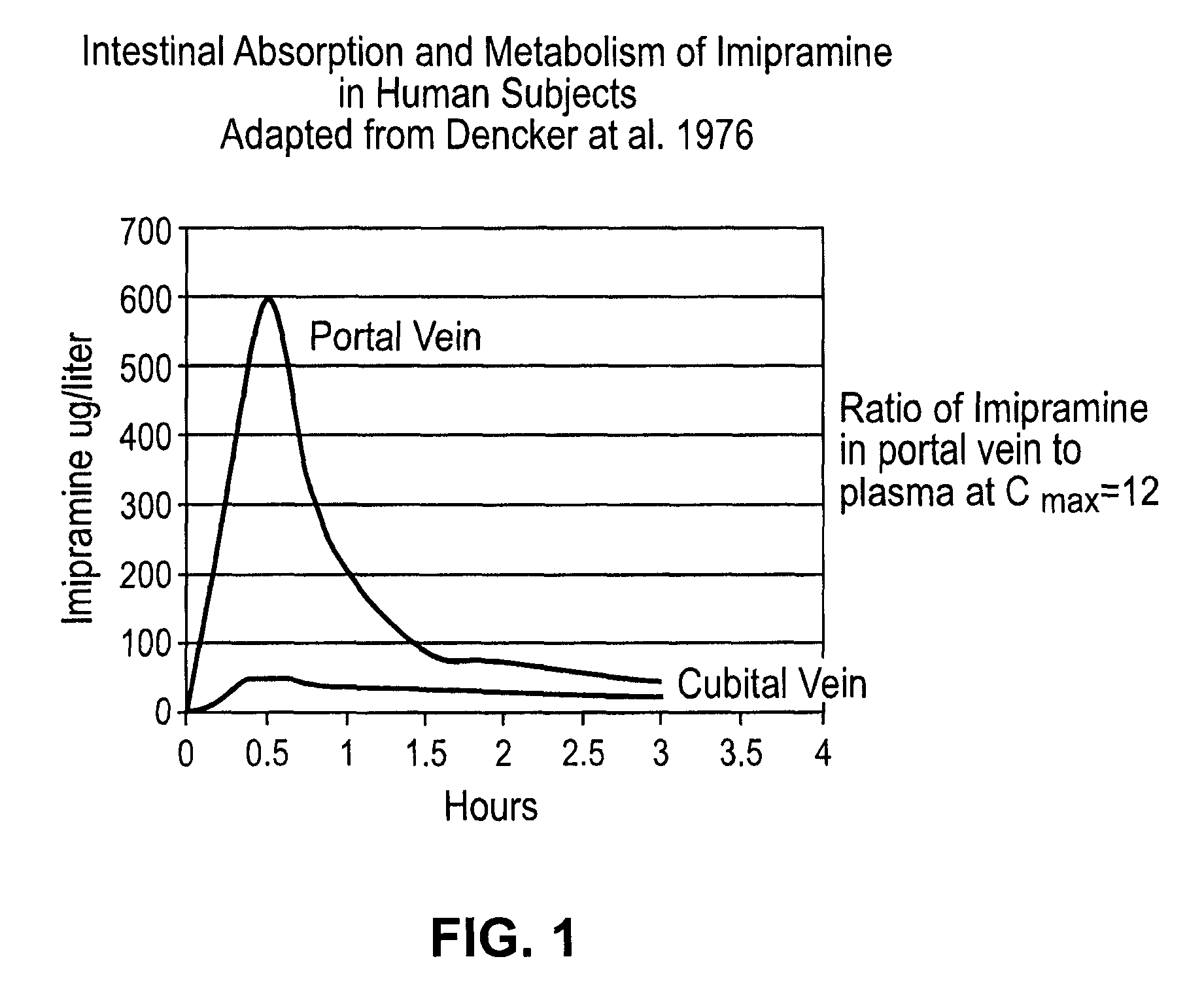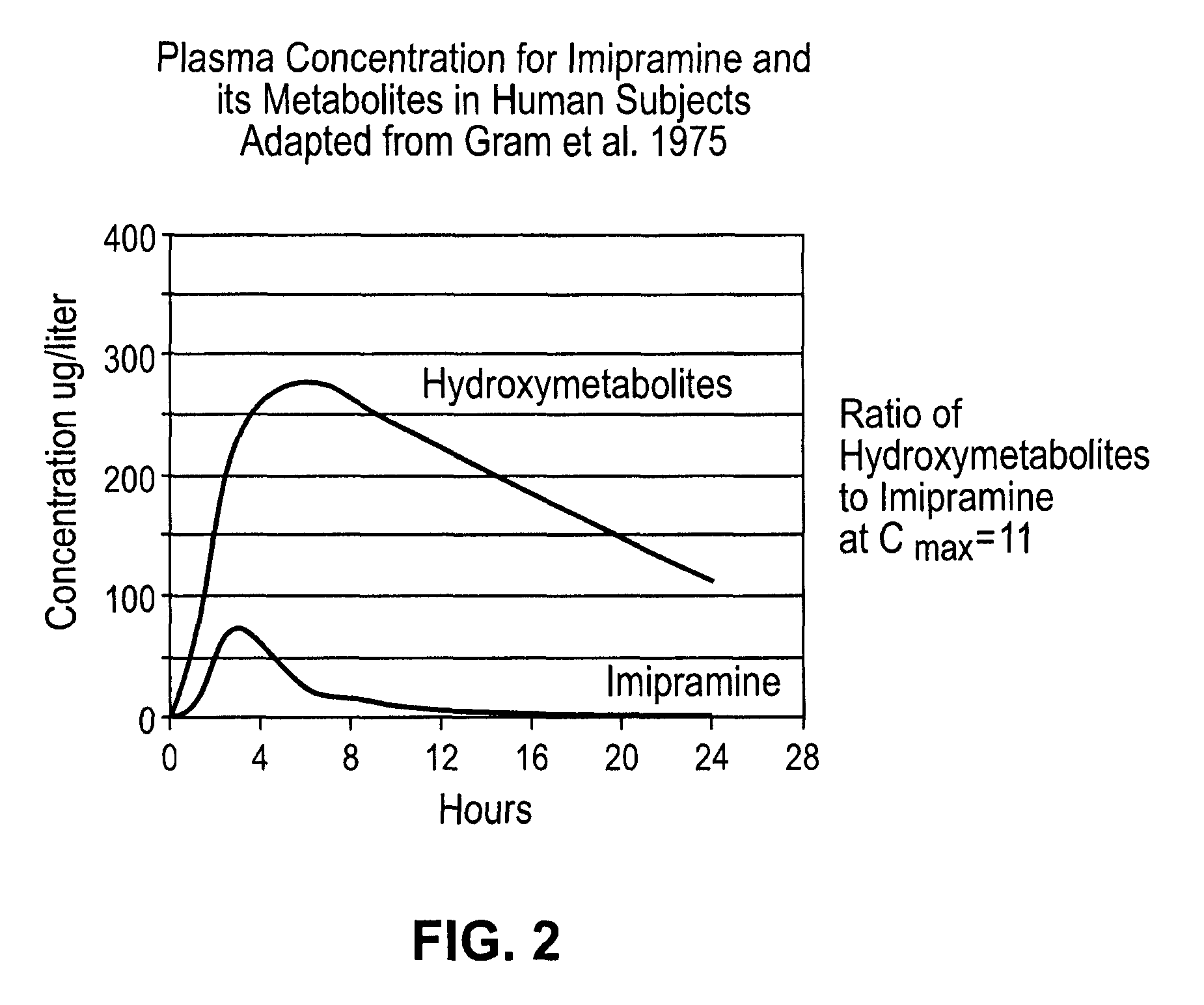Noncardiotoxic pharmaceutical compounds
a non-cardiotoxic, pharmaceutical technology, applied in the direction of drug compositions, antibacterial agents, immunological disorders, etc., can solve the problems of slowed cardiac conduction, impaired cardiac contractility and possible ventricular dysrhythmias, and inhibition of repolarization, so as to reduce the pka value and reduce the effect of cardiotoxicity
- Summary
- Abstract
- Description
- Claims
- Application Information
AI Technical Summary
Benefits of technology
Problems solved by technology
Method used
Image
Examples
example 1
Synthesis of [3-(10,11-Dihydro-dibenzo[b,f]azepin-5-yl)-propyl]-methyl-phosphoramidic acid diethyl ester
[0274]
[0275]Desipramine hydrochloride (1 equivalent, 0.5 gram) was added drop wise to a stirred solution of potassium carbonate (2 equivalents, 0.456 gram) in dry DMF at 0° C. Diethylchlorophosphate (1.2 equivalents, 0.33 ml) which had been dissolved in dry DMF was added drop wise to this mixture and stirred for 12 hours at room temperature. The reaction mixture was quenched with water, extracted with ethyl acetate, the organic layer separated, washed with brine solution and dried over anhydrous sodium sulfate. The dried material was concentrated and purified by column chromatography to provide a pale yellow liquid (yield: 0.33 gram) and analyzed by HPLC (purity 93.1%). The FTIR, MS and 1H NMR spectra were consistent with the assigned with the empirical formula of C22H31N2O3P.
example 2
Synthesis of [3-(10,11-Dihydro-dibenzo[b,f]azepin-5-yl)-propyl]-methyl-carbamic acid methyl ester
[0276]
[0277]Desipramine hydrochloride (1 equivalent, 0.3 gram) was added drop wise to a stirred solution of potassium carbonate (2 equivalents, 0.27 gram) in dry DMF at 0° C. Methyl chloroform (1.2 equivalents, 0.1 ml) which had been dissolved in dry DMF was added drop wise to this mixture and stirred for 6 hours at room temperature. The reaction mixture was quenched with water, extracted with ethyl acetate, the organic layer separated, washed with brine solution and dried over anhydrous sodium sulfate. The dried material was concentrated and purified by column chromatography to provide a pale yellow liquid (yield: 0.18 gram) and analyzed by HPLC (purity 97.7%). The FTIR, MS and 1H NMR spectra were consistent with the assigned with the empirical formula of C20H24N2O2.
example 3
Synthesis of [3-(10,11-Dihydro-dibenzo[b,f]azepin-5-yl)-propyl]-methyl-carbamic acid propyl ester
[0278]
[0279]Desipramine hydrochloride (1 equivalent, 0.2 gram) was added drop wise to a stirred solution of potassium carbonate (5 equivalents, 0.45 gram) in dry DMF at 0° C. Propyl chloroform (1.5 equivalents, 0.1 ml) which had been dissolved in dry DMF was added drop wise to this mixture and stirred for 6 hours at room temperature. The reaction mixture was quenched with water, extracted with ethyl acetate, the organic layer separated, washed with brine solution and dried over anhydrous sodium sulfate. The dried material was concentrated and purified by column chromatography to provide a yellow liquid (yield: 0.12 gram) and by HPLC (purity 95.7%). The FTIR, MS and 1H NMR spectra were consistent with the assigned structure with the empirical formula of C22H28N2O2.
PUM
| Property | Measurement | Unit |
|---|---|---|
| pH | aaaaa | aaaaa |
| pKa | aaaaa | aaaaa |
| pKa | aaaaa | aaaaa |
Abstract
Description
Claims
Application Information
 Login to View More
Login to View More - R&D
- Intellectual Property
- Life Sciences
- Materials
- Tech Scout
- Unparalleled Data Quality
- Higher Quality Content
- 60% Fewer Hallucinations
Browse by: Latest US Patents, China's latest patents, Technical Efficacy Thesaurus, Application Domain, Technology Topic, Popular Technical Reports.
© 2025 PatSnap. All rights reserved.Legal|Privacy policy|Modern Slavery Act Transparency Statement|Sitemap|About US| Contact US: help@patsnap.com



